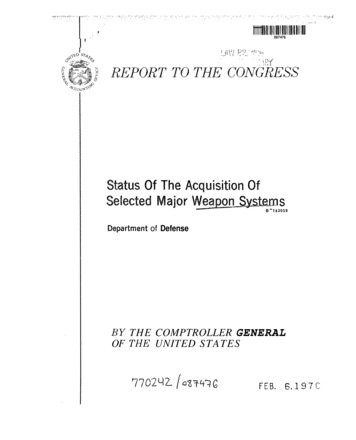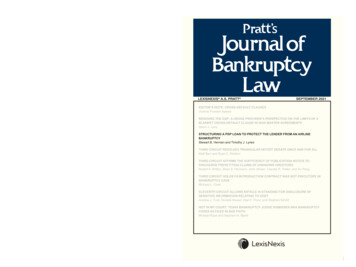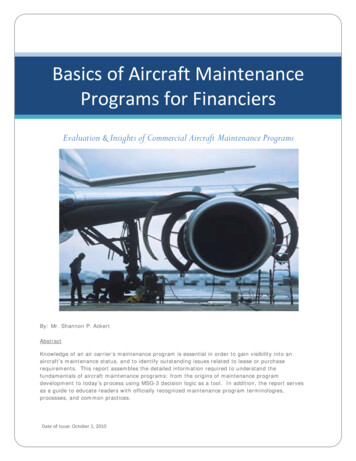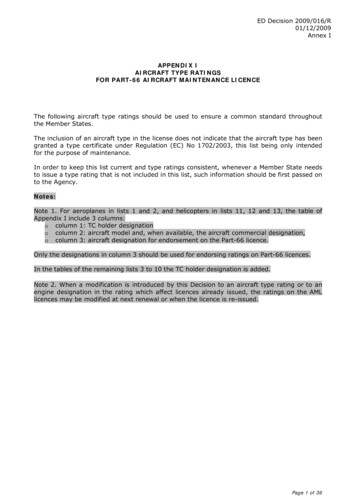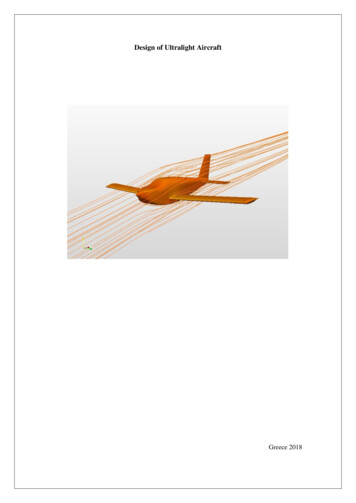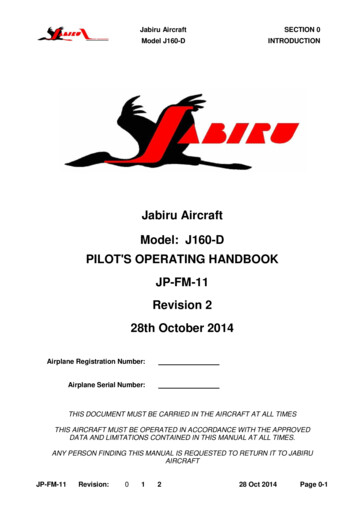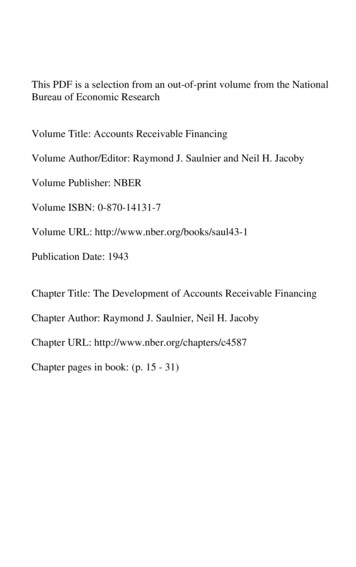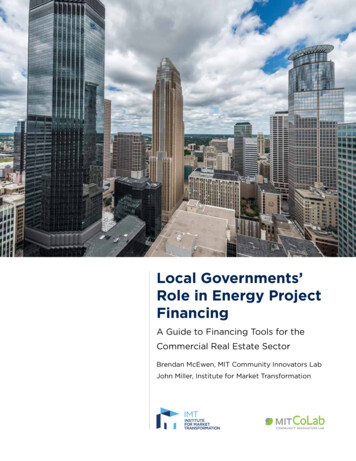
Transcription
2nd Meeting of Authority on 09.09.2020Subject: Inclusion of Aircraft Financing & Leasing as a financial product in theIFSCA ActIt is brought to the notice of the Authority that on peer review conducted bythe IFSCA, it is observed that similar jurisdictions offer aircraft leasing, includingoperating lease as financial product and the majority of the business on this front ason date is being handled by IFSC Dublin. At the same time, it is to be understoodthat the Indian aviation industry mostly depends on these foreign jurisdictions tocater to the demands on aircraft leasing, mainly operating leases and hence it isdesirable to get back this business to GIFT IFSC.2.Over a period of time, GIFT IFSC could also emerge as a aircraft leasingcentre for the sub-region/region. Besides, gradually it would also promote the relatedMaintenance, Repair & Overhaul (MRO) business in India. As per the data availableIndia is able to cater to only 1% of the global MRO market worth 45 Bn today where as it is already the third largest domestic aviation market in the worldand a need is felt to augment the domestic capacities to garner a larger share of theinternational business.3.A working group constituted by the Ministry of Civil Aviation to study thepotential of Aircraft leasing business submitted its report titled ‘Project RupeeRaftaar: Development of Aircraft Financing & Leasing in India’ recommendingsetting up of a structure for aircraft financing and leasing in GIFT IFSC. The reportrecommends facilitation of aircraft financing and leasing through Banks, NBFC’sand Alternate Investment Funds.4.Taking note of the huge potential such businesses bring to the ecosystem andthe synergies it could create for fast tracking the development of GIFT IFSC in to aglobal hub for aircraft financing and leasing. A detailed note in this regard is attachedseparately to this agenda as Annexure for the reference of the members.5. Though aircraft leasing and financing activity is broadly covered under ‘CreditArrangements’ as mentioned in S.3(1) (d) (iv), removal of the ambiguity byspecifically mentioning aircraft leasing including operating lease as a financialproduct would go a long way in improving the ease of doing business within the1 Page
2nd Meeting of Authority on 09.09.2020IFSC. In view of the same, we hereby recommend that the following be approvedby the Authority;a.) Recommending to the Government for inclusion of Aircraft financingand leasing, including operating lease, as a Financial Product underS.3(1)(d) of the IFSCAA by virtue of powers granted to it under S.12(2)(b)& (c) of the same Act.b.) Recommending to the RBI that operational guidelines for NBFCs toparticipate in IFSC should include aircraft financing and leasing,including operating lease, as a permissible activity.6.The same is submitted for the consideration and approval of theAuthority.2 Page
2nd Meeting of Authority on 09.09.2020AIRCRAFT FINANCING AND LEASING BY NON-BANKING FINANCIALCOMPANIES IN THE INTERNATIONAL FINANCIAL SERVICES CENTRE1. Background1.1 The aircraft financing and leasing industry has developed significantly over a period of timeworldwide. Countries like Ireland, USA, China, Singapore and Hong Kong have becomeglobal hubs for this industry by setting up an effective regulatory environment to facilitateaircraft lease and financing. The Indian domestic airline industry operates more than 80% ofits aircrafts on lease, which is significantly greater than the global share of 53%.1 India hasbecome the third largest domestic passenger market in the world and is expected to overtakethe United Kingdom to become the third largest in the combined domestic and internationalpassenger market by 2024, from its current seventh position.2 Further, the rising demand inthe sector has pushed the number of aircrafts operating in the sector which is expected to reach1100 aircrafts by 2027.3 As per a study4, the aircraft leasing market size is estimated toincrease to USD 62 Billion by 2023 recording a compound annual growth rate of 4.7% from2017 to 2023.1.2 So far, India has participated as a consumer of international financial services for financingits acquisition of aircrafts on a lease basis. There is an immense business opportunity in Indianin terms of financing and leasing aircrafts as financiers and lessors through the GIFTInternational Financial Services Centre (“IFSC”), and it appears that the time is ripe to alignIndia’s regime with other global leaders in this area. In order to tap this massive potential ofthe Indian aviation industry, the Government of India is considering developing an effective1Centre for Aviation, “Aircraft Leasing in India, opportunity knocks for the Indian lessor”, September 2018, availableat: craft-leasing-in-india-opportunity-knocks-for-an- indian-lessor443995 last accessed 28 August 20202India Brand Equity Foundation, “Indian Aviation Industry Report”, https://www.ibef.org/industry/indian-aviation.aspx last accessed 28 August 20203July2020,availableat:Ibid.4Market Research Future, Global Aircraft Leasing Industry to Continue its Growth in a Vertical Manner, GlobeNewswire,5September2018,availableat: erticalManner.html#: :text e%20forecast%20period last accessed 28 August 20203 Page
2nd Meeting of Authority on 09.09.2020regulatory mechanism to enable aircraft financing and leasing in India.5 It is proposed that theIFSC may be a key enabler for this purpose, by providing the required regulatory frameworkand a competitive tax regime to compete with other global hubs in this industry.1.3 In 2018, a Working Group constituted by the Ministry of Civil Aviation to study thedevelopment and potential of aircraft financing and leasing in India prepared a report titledthe “Project Rupee Raftaar: Development of Aircraft Financing and Leasing in India”(“Rupee Raftaar Report”) recommending the setting up of a structure for aircraft financingand leasing in GIFT IFSC. The Report recommends facilitation of aircraft financing throughvarious institutions in the IFSC including Banks, Non-Banking Financial Companies(“NBFCs”), Alternative Investment Funds (“AIFs”) etc. In light of the above, this noteintends to briefly cover certain issues that may require being considered for development ofthis industry in the IFSC. Since the IFSCA intends to develop the aircraft leasing industry inthe IFSC primarily through NBFCs, and hence, the scope of this note is limited to examiningthe issues relating to developing such industry through NBFCs in the IFSC.2. Aircraft Financing and Leasing by NBFCs2.1 Section 45-I(c)(i) of the Reserve Bank of India Act, 1934 (“RBI Act”) permits NBFCs toengage in financing, whether by way of making loans or advances or otherwise, of any activityother than its own. However, an exception in terms of industrial activity is provided, whereinan NBFC which carries on an ‘industrial activity’ as it principal business is not covered underthe definition of an NBFC.6 The term ‘industrial activity’ as defined under the IndustrialDevelopment Bank Act, 1964 (and incorporated by reference in the RBI Act) includes‘leasing, sub-leasing or giving on hire or hire purchase of industrial plants, equipment,machinery or other assets including vehicles, ships and aircraft.’ Therefore, a concern mayarise as to whether an aircraft leasing entity which meets the eligibility criteria for an NBFCqualifies as an NBFC due to the above-mentioned exception.2.2 It is pertinent to note that the activity of ‘equipment leasing’ was expressly classified as apermissible activity for NBFCs under Chapter V of the Finance Act, 19947 (upto 30 June5Working Group, Ministry of Civil Aviation, Government of India, Project Rupee Raftaar: Development of 9,availableat: ECTRUPEERAFTAAR.pdf last accessed 28 August 20206Proviso (as) to Section 3(c), The RBI Act7Section 65(12), The Finance Act 1994: “banking and other financial services” means –(a) the following servicesprovided by a banking company or a financial institution including a non-banking financial company or any otherbody corporate [or commercial concern], namely: (i) financial leasing services including equipment leasing and hirepurchase. Please note that Chapter V of the Finance Act, 1994 was withdrawn w.e.f 1.7.2012 vide Notification no.18/2012 ST dated 1.6.2012 read with Notification no. 20/2012 ST dated 5.6.2012.4 Page
2nd Meeting of Authority on 09.09.20202012) as well as under the extant RBI regulations.8 However, with the re-categorisation ofNBFCs from four categories (i) equipment leasing, (ii) hire-purchase, (iii) investmentcompanies and (iv) loan companies, to three categories (i) asset finance companies9, (ii)investment companies, and (iii) loan companies10 and now into one combined category calledInvestment and Credit Company11, it may be inferred that the activity may still be permissible,albeit implicitly.12 As per the Rupee Raftaar Report, various leasing entities have obtainedregistration as NBFCs with RBI.13 While the term “Equipment Lease” is not statutorilydefined in India, paragraph 37(e) of Indian Accounting Standard – 16 (Ind AS8RBI Master Circular on Para-Banking Activities, 1 July 2015, para 8.2(g), available at: https://www.rbi.org.in/scripts/BS ViewMasCirculardetails.aspx?id 9837 ; RBI Circular on Reclassification ofNBFCs, December 2006, available at: https://www.rbi.org.in/scripts/BS CircularIndexDisplay.aspx?Id 3200 9The Master Circular – “Non-Banking Financial Companies Acceptance of Public Deposits (Reserve Bank)Directions, 1998” (which has now been superseded) defined "equipment leasing company" to mean any companywhich is a financial institution carrying on as its principal business, the activity of leasing of equipment. In the AnnualReturn to be filed by NBFCs under the said directions, under the details on assets and liabilities, in part 7, the natureof equipment on lease appears to be categorized into plant & machinery, data processing / office equipment, vehiclesand others. (emphasis supplied) Further, the 2006 RBI circular re-categorising equipment leasing company and hirepurchase company into asset finance company defined asset finance companies as “any company which is a financialinstitution carrying on as its principal business the financing of physical assets supporting productive / economicactivity, such as automobiles, tractors, lathe machines, generator sets, earth moving and material handlingequipments, moving on own power and general purpose industrial machines.” (emphasis supplied). It appears that theambit of equipment leasing under the 1998 Master Directions, and the ambit of asset finance companies under the2006 RBI circular is broad and is not intended to be exhaustive. See, RBI ilable at: https://www.rbi.org.in/scripts/BS CircularIndexDisplay.aspx?Id 3200 10Reserve Bank of India, RBI Circular on Re-classification of NBFCs, December 2006, available at: https://www.rbi.org.in/scripts/BS CircularIndexDisplay.aspx?Id 3200 11Reserve Bank of India, RBI Circular on Harmonization of Different Categories of NBFCs, 22 February 2019available at: px?Id 11483&Mode 0 last accessed 28 August202012Please note that Annex IV of Master Direction - Non-Banking Financial Company - Systemically Important NonDeposit taking Company and Deposit taking Company (Reserve Bank) Directions, 2016 specifically provides forprovision of operating and financial lease under the head of “Asset Financing” in the draft Balance Sheet for NBFCs.This may imply that offering operating and financial lease is within the scope of NBFCs, RBI Master Direction - NonBanking Financial Company - Systemically Important Non-Deposit taking Company and Deposit taking Company(ReserveBank)Directions, 2016,availableat: https://www.rbi.org.in/Scripts/BS ViewMasDirections.aspx?id 10586 ; Also, See similar provision in RBI MasterDirection - Non-Banking Financial Company – Non-Systemically Important Non-Deposit taking Company (ReserveBank) Directions, 2016, available at: https://www.rbi.org.in/Scripts/BS ViewMasDirections.aspx?id 10585 lastaccessed 28 August 202013Working Group, Ministry of Civil Aviation, Government of India, Project Rupee Raftaar: Development 019;availableat: ECTRUPEERAFTAAR.pdf last accessed 28 August 20205 Page
2nd Meeting of Authority on 09.09.202016) on Property, Plant and Equipment14 explicitly includes aircrafts within the purview ofproperty, plant and equipment, thereby indicating that ‘equipment leasing may possiblyinclude aircraft leasing.From the above, it appears that for abundant caution, a clarification in terms of permittingaircraft financing and leasing as a permitted activity of NBFCs in IFSC may be provided, toenable building an unambiguous regulatory environment for such industry.3. Aircraft Financing and Leasing in IFSCs3.1 The International Financial Services Centres Authorities Act, 2019 (the “IFSCA Act”)empowers the IFSCA to regulate financial services, financial products and financialinstitutions in the IFSC. The definition of financial products under Section 3(1)(d) includes“credit arrangements”. While the term by itself has not been defined in the IFSCA Act, thereport of the Financial Sector Legislative Reports Commission (“FSLRC Report”), whichformed the basis of the IFSCA Act, defines credit arrangements to include credit facilities(secured or unsecured loans) and credit transactions.15 Credit transactions are further definedto include lease transactions and secured loans.16 Thus, it may be reasonably inferred that asimilar interpretation may be given to Section 3(1)(d) in the IFSCA Act, and an aircraftlease/finance may fall within the scope of “financial products” under the IFSCA Act by virtueof being in the nature of a credit arrangement.3.2 Leasing of aircrafts usually occurs through either of the two modes i.e. (i) Operational Leaseor (ii) Financial Lease. In case of a finance lease, all the risks and rewards incidental toownership are transferred to the lessee, and in most cases, the title is also eventuallytransferred to the lessee. In other words, in case of “finance lease”, the lessee may use theasset for its entire economic life and thereby acquires risks and rewards incidental to theownership of such assets. It is in the nature of a financial loan.17 On the other hand, a lease14Ministry of Corporate Affairs, “Indian Accounting Standard 16- Prescribing the accounting treatment for property,plant and equipment”, available at: https://mca.gov.in/Ministry/pdf/INDAS16.pdf last accessed 28 August 202015Section 2(43), Draft of the Indian Financial Code, 2013; Volume II: Report of the Financial Sector LegislativeReforms Commission, available at: https://dea.gov.in/sites/default/files/fslrc report vol2 1.pdf last accessed 28August 202016Section 2(46), Draft of the Indian Financial Code, 2013: “credit transaction” means an arrangement, irrespectiveof its form, which is – (a) a lease; (b) a mortgage agreement or secured loan; (c) an instalment agreement; or (d) anyother agreement other than a credit facility or credit guarantee, in terms of which payment of an amount owed byone person to another is deferred thereby attracting a liability to pay a charge, fee or interest to the credit provider inrespect of – (i) the agreement; or (ii) the amount that has been deferred, Volume II: Report of the Financial SectorLegislative Reforms Commission, available at: https://dea.gov.in/sites/default/files/fslrc report vol2 1.pdf 17See, Association of Leasing and Finance Companies v. Union of India, (2011) 2 SCC 352; Para 206 Page
2nd Meeting of Authority on 09.09.2020is classified as an operating lease if it does not transfer substantially all the risks and rewardsincidental to ownership of an underlying asset.18 Operating leases are usually resorted to whenthe use of an asset is for a particular period which is shorter than the economic life of the asset.This makes operating leases more attractive than finance leases for aircraft leasing. A pureoperating lease provides the lessee with the use of an aircraft for the prescribed term inconsideration for payment of rent. At the expiry of the prescribed term, the lessee is obligedto return the aircraft to the lessor and has no further legal or economic interest in the residualvalue of that aircraft. It is expected that approximately half of all aircrafts worldwide will beunder an operating lease in the next decade.19 As per the Rupee Raftaar Report, in India, over70% of the aircraft acquisitions over the last decade have been on an operating lease basis andthe trend is expected to continue in the future.203.3 An aircraft lease (whether operating or finance lease) is more often than not, given effect tothrough a Sale-and-Leaseback model (SLB), wherein an airline acquires the aircraft, sells thesame to the lessor and leases it back for its own use. The SLB model provides a method offinancing, frees up equity tied in the aircraft (for the lessee) and is also beneficial for thepurpose of controlling tax consequences, and is therefore the preferred model when it comesto aircraft financing. Low-cost carriers (LCC) in India, such as Indigo airlines, usually procureaircrafts through SLB backed operating leases.213.4 We have been given to understand that the nature of operating leases may raise a concern asto whether they can be classified as a financial service/ financial product under the IFSCAAct. The Foreign Direct Investment Policy, 2012 (“FDI Policy”) specifically indicated thatthe activity of leasing and finance in the context of foreign investment in NBFCs includesonly finance lease and not operating leases.2218Ministry of Corporate Affairs, Indian Accounting Standard- 116, Para 62, available https://www.mca.gov.in/Ministry/pdf/RuleIndAsEng 30032019.pdf last accessed 28 August 2020at:19International Air Transport Association: Guidance Material and Best Practices for Aircraft Leases, y2017,availableat: 8b3d004b0d6d0916f/ac-leases-4th-edition.pdf last accessed28 August 202020Working Group, Ministry of Civil Aviation, Government of India, Project Rupee Raftaar: Development 019,availableat: ECTRUPEERAFTAAR.pdf last accessed 28 August 202021Satyendra Pandey, “Why sale and leaseback is the centerpiece of IndiGo’s massive aircraft orders”, CNBC TV18, October 31,2017, available at: ive-aircraft-orders-4617661.htm last accessed 28 August 202022Department of Industrial Policy and Promotion, Ministry of Commerce and Industry, Government of .2.24.2availableat: https://dipp.gov.in/sites/default/files/FDI Circular 01 2012%20%203 0.pdf ; Please note that the FDI Policy of2017 does not refer to leasing & finance operations and do not make any reference to operating and finance leases.7 Page
2nd Meeting of Authority on 09.09.20203.5 The aforesaid issue pertaining to operating and finance leases is pertinent in the currentcontext because financial institutions (including NBFCs) are permitted to offer only financialservices in respect of financial products in an IFSC as per the IFSCA Act.23 For this aspect,the following sections of the note delve into the international and Indian perspective.4. International and Indian Perspective: Operational v. Finance LeaseA. Commercial Law4.1 On a review of the commercial laws of certain jurisdictions, it appears that they do notdifferentiate between financial and operating leases. Under the commercial law in Singapore,there is no concept of a financial lease as understood under the Indian regime. In fact, a financelease is defined as a contractual arrangement where the owner leases goods to usually onehirer (who pays rent for the use of the goods) for the estimated working life of the goods24.Unlike a hire-purchase, no option to purchase is conferred upon the hirer by the leaseagreement. Thus, a conventional operating lease (wherein the property in the leased goodsnever passes to the lessee) is covered within the scope of a financial lease under thecommercial law of Singapore. Furthermore, finance companies in Singapore, establishedunder the Finance Companies Act (Cap. 108) are authorized to provide credit facilities by wayof such a lease.25 Apart from Singapore, even the Irish commercial law also does not makeany distinction between an operating and a financial lease.264.2 On the other hand, a perusal of the laws pertaining to Dubai Financial Services Centre(“DFSC”) indicate that only financial leases are recognized as financial products in the DFSC.As per the General Module of the Dubai Financial Service Authority (DFSA) Rulebook, afinancial product includes a credit facility27, which in turn, includes any loan or23Section 3(c), The IFSC Act: "financial institution" means a unit set up in an International Financial ServicesCentre and which is engaged in rendering financial services in respect of any financial product.24Commercial Law of Singapore, Law of Credit and Security, Chapter 11,Section 5, available at: rity lastaccessed 28 August 202025See, Finance Companies Act (Chapter 108); Also see, Commercial Law of Singapore, Law of Credit and Security,Chapter 11, Section 5, available at: ity last accessed 28 August 202026Deloitte Touche Tohmatsu Limited, “Report on Aircraft Leasing in Ireland Crossing Borders”, 2014, available at: Documents/Tax/crossing%20boarders%20.pdf last accessed28 August lableat: les/net file store/DFSA1547 1843 VER500.pdf last accessed27 August 20208 Page
2nd Meeting of Authority on 09.09.2020syndicated loan, mortgage, overdraft, financial lease, letter of credit, transaction finance etc.28(emphasis supplied). However, the term ‘financial lease’ is not defined further and thereforeit is not clear if the same includes an operational lease.4.3 The definition of financial products under Section 3(1)(d) of the IFSCA Act includes “creditarrangements”. As indicated earlier, the FSLRC report defines credit arrangements to includecredit transactions, which in turn includes leases and loans. Unlike the DFSC laws, the FSLRCdefinition does not restrict credit transactions only to financial leases. This may be interpretedto imply that all types of leases, without any categorization into operational and financiallease, may possibly be included within the definition of credit arrangements under the IFSCAAct.B. Accounting Treatment4.4 The Ministry of Corporate Affairs (“MCA”) notified new accounting standards for leases on30 March 2019 i.e. Ind AS 11629 which are largely based on the International FinancialReporting Standard 16 (FIRS 16). The IFRS 16 for lease accounting was introduced by theInternational Accounting Standards Board (IASB) and globally came into force on January 1,2019. The Ind AS 116 is applicable for annual reporting periods beginning on or after 1 April2019.30 With regard to NBFCs, in accordance with the MCA notification dated 30 March2016, all NBFCs, apart from NBFCs with a net worth below INR 250 Crore, are required tocomply with the Ind AS from April 1, 2019. Accordingly, NBFCs are required to comply withall rules of accounting as specified in the Ind AS, including Ind As 116.4.5 The IFRS 16 takes a new approach to accounting for leases, called the ‘right-of-use’ model.As per paragraph 9 of IFRS 16 “A contract is, or contains, a lease if it conveys the right tocontrol the use of an identified asset for a period of time in exchange for consideration’ TheInd AS 116 dilutes the difference between operating and finance leases by adopting the ‘rightof-use’ model as prescribed in IFRS 16. This means that if a company has control over, orright to use, an asset they are renting, it is classified as a lease for accounting purposes and,under the new rules, must be recognized on the company’s balance : les/net file store/DFSA1547 5717 VER510.pdf last accessed27 August 202029Ministry of Corporate Affairs, Indian Accounting Standard- 116, available at: https://www.mca.gov.in/Ministry/pdf/RuleIndAsEng 30032019.pdf last accessed 27 August 202030Scheduled Commercial Banks (SCBs) excluding Regional Rural Banks (RRBs) were initially required to implementInd AS from 1 April 2018. However, RBI vide a press release dated 5 April 2018, deferred the implementation of IndAS by one year. Thereafter, the RBI through a notification dated 22 March 2019, has further deferred the Ind ASimplementation till further notice. Please see http://www.caparivaar.in/wp- h-22-2019.pdf 9 Page
2nd Meeting of Authority on 09.09.2020This essentially eliminates the distinction between operating and financial leases in so far asaccounting treatment is concerned. In other words, significant financial liabilities can nolonger be held off-balance sheet, as permitted previously for operating leases (under Ind AS17)31. However, it may be noted that the harmonization of operating and financial leases forthe purpose of accounting treatment is made only in the books of the lessee and not thelessor.324.6 Broadly, the definition of a financial product as provided under the IFSCA Act which may beinterpreted to include ‘leases’, coupled with the gradual dilution of the distinction betweenoperating and financial leases for the purpose of accounting, may indicate that an operatinglease may be classified as a financial product in the context of the Indian regulatory regime.Moreover, as indicated earlier, most global hubs for aviation finance and leasing such asSingapore and Ireland do not differentiate between operational and finance leases under theircommercial laws. This ensures smoother facilitation of aircraft leasing and financing. As theIndian government intends to develop India as a global hub for aircraft leasing/financethrough IFSCs, it is may be beneficial to recognize all kinds of aircraft leasing structures asfinancial products, to the extent possible, so as to facilitate entities in the IFSCs to leverageIndia’s potential in this industry. The Union Finance Minister in her Budget speech 2019stated that the time is ripe for India to enter into aircraft financing and leasing.5. RecommendationsBased on the aforesaid justification and in order to remove any sort of ambiguity with respectto the subject matter, it is recommended that Government may specifically add aircraftfinancing & leasing activity, including operating lease, as a Financial Product in IFSC, byexercising the powers vested with it in terms of Section 3 (1) (d) (e) and 12 (2) (b) and (c) ofthe IFSCA Act. Further, in consonance with the proposed notifications under the IFSCAAct, the RBI in its operating guidelines for NBFCs to participate in IFSC may also clarifythat aircraft leasing, including operating lease, is a permissible activity for NBFCs in Standard https://mca.gov.in/Ministry/pdf/INDAS17.pdf last accessed 27 August 20203217,availableat:Please note that in so far as aircraft leasing is concerned, Banks and NBFCs are usually in the position of the lessor.The Ind AS 116 has implications on the accounting of lessees, and not lessors and this aspect may require furtherexamination.10 P a g e
of equipment on lease appears to be categorized into plant & machinery, data processing / office equipment, vehicles and others. (emphasis supplied) Further, the 2006 RBI circular re-categorising equipment leasing company and hire-purchase company into asset finance company defined asset finance companies as "any company which is a financial
